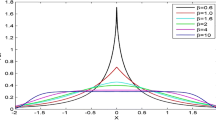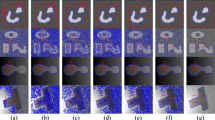Abstract
Image segmentation is still a challenging task in image processing field because of unpredictable noise and intensity inhomogeneity in images. In this paper, we present a novel active contour model for image segmentation by constructing a robust truncated kernel function. It utilizes image patches to perceive the neighborhood intensities of pixel at the same time considers the spatial distance within a local window. By using this truncated kernel function, the proposed method can accurately segment images with intensity inhomogeneity while guaranteeing certain noise robustness. Extensive evaluations on synthetic and real images are provided to demonstrate the superiority of our method. The model makes full use of image patch information to strengthen the robustness against noise and intensity inhomogeneity in images.















Similar content being viewed by others
References
Wang L, He L, Mishra A, Li C (2009) Active contours driven by local Gaussian distribution fitting energy. Signal Process 89:2435–2447
Wu LK, Yang MS (2002) Alternative c-means clustering algorithms. Pattern Recogn 35(10):2267–2278
Malladi R, Sethian JA, Vemuri BC (1995) Shape modeling with front propagation: a level set approach. IEEE Trans Pattern Anal Mach Intell 17(2):158–175
Li C, Xu C, Gui C, Fox MD (2005) Level set evolution without re-initialization: a new variational formulation. In: Proceedings of IEEE conference on computer vision and pattern recognition (CVPR), vol 1, pp 430–436
Vasilevskiy A, Siddiqi K (2002) Flux-maximizing geometric flows. IEEE Trans Pattern Anal Mach Intell 24:1565–1578
Yang X, Gao XB, Li J, Han B (2014) A shape-initialized and intensity-adaptive level set method for auroral oval segmentation. Inf Sci 277:794–807
Wang Y, Xiang S, Pan C, Wang L, Meng G (2013) Level set evolution with locally linear classification for image segmentation. Pattern Recogn 46(6):1734–1746
Zhao YQ, Wang XH, Wang XF, Shih FY (2014) Retinal vessels segmentation based on level set and region growing. Pattern Recogn 47(7):2437–2446
Thapaliya K, Pyun JY, Park CS, Kwon GR (2013) Level set method with automatic selective local statistics for brain tumor segmentation in MR images. Comput Med Imag Graph 37(7):522–537
Wang XF, Min HH, Zhang YG (2015) Multi-scale local region based level set method for image segmentation in the presence of intensity inhomogeneity. Neurocomputing 151:1086–1098
Wang L, Shi F, Li G, Gao YZ, Lin WL, Gilmore JH, Shen DG (2014) Segmentation of neonatal brain MR images using patch-driven level sets. Neuroimage 84:141–158
Zhang K, Song H, Zhang L (2010) Active contours driven by local image fitting energy. Pattern Recogn 43:1199–1206
Zhang K, Zhang L, Lam KM, Zhang D (2015) A level set approach to image segmentation with intensity inhomogeneity. IEEE Trans Cybern 46(2):546–557
Chan T, Vese L (2001) Active contours without edges. IEEE Trans Image Process 10:266–277
An J, Rousson M, Xu C (2007) Gamma-convergence approximation to piecewise smooth medical image segmentation, medical image computing and computer-assisted intervention (MICCAI), vol 2. Springer, Berlin Heidelberg, pp 495–502
Li C, Kao C, Gore J, Ding Z (2007) Implicit active contours driven by local binary fitting energy. In: Proceedings of IEEE conference on computer vision and pattern recognition (CVPR). IEEE Computer Society, Washington, DC, pp 1–7
Le T, Luu K, Savvides M (2013) SparCLeS: Dynamic ℓ1 sparse classifiers with level sets for robust beard/moustache detection and segmentation. IEEE Trans Image Process 22:3097–3107
Wang H, Huang TZ, Xu Z, Wang Y (2014) An active contour model and its algorithms with local and global Gaussian distribution fitting energies. Inf Sci 263:43–59
Wang L, Li C, Sun Q, Xia D, Kao CY (2009) Active contours driven by local and global intensity fitting energy with application to brain MR images segmentation. Comput Med Imag Graph 33:520–531
Buades A, Coll B, Morel JM (2005) A review of image denoising algorithms, with a new one. Multiscale Model Simul 4(2):490–530
Zhang K, Zhang L, Yang M-H (2014) Fast compressive tracking. IEEE Trans Pattern Anal Mach Intell 36(10):2002–2015
Ji Z, Xia Y, Sun Q, Cao G, Chen Q (2015) Active contours driven by local likelihood image fitting energy for image segmentation. Inf Sci 301:285–304
Wang T, Sun Q, Ji Z, Chen Q, Fu P (2016) Multi-layer graph constraints for interactive image segmentation via game theory. Pattern Recogn 55:28–44
Wang T, Ji Z, Sun Q, Chen Q, Yu S, Fan W, Yuan S, Liu Q (2016) Label propagation and higher-order constraint-based segmentation of fluid-associated regions in retinal SD-OCT images. Inform Sci 358 (C):92–111
Wang T, Ji Z, Sun, Chen Q, Jing X (2016) Interactive multilabel image segmentation via robust multi-layer graph constraints. IEEE Trans Multimed 18(12):2358–2371
Paragios N, Deriche R (2002) Geodesic active regions and level set methods for supervised texture segmentation. Int J Comput Vis 46:223–247
Coupé P, Manjón J, Fonov V, Pruessner J, Robles M, Collins DL (2011) Patch-based segmentation using expert priors: application to hippocampus and ventricle segmentation. Neuroimage 54:940–954
Wang XF, Huang DS, Xu H (2010) An efficient local Chan–Vese model for image segmentation. Pattern Recogn 43(3):603–618
Osher S, Sethian JA (1988) Fronts propagating with curvature dependent speed: algorithms based on Hamilton–Jacobi formulations. J Comput Phys 79(1):12–49
Ge Q, Xiao L, Zhang J, Wei Z (2012) An improved region-based model with local statistical features for image segmentation. Pattern Recogn 45(4):1578–1590
Wang L, Wu H-Y, Pan C (2013) Region-based image segmentation with local signed difference energy. Pattern Recogn Lett 34(6):637–645
Li C, Kao C-Y, Gore JC, Ding Z (2008) Minimization of region-scalable fitting energy for image segmentation. IEEE Trans Image Process 17(10):1940–1949
Lankton S, Tannenbaum A (2008) Localizing region-based active contours. IEEE Trans Image Process 17 (11):2029–2039
Li C, et al (2011) A level set method for image segmentation in the presence of intensity inhomogeneities with application to MRI. IEEE Trans Image Process 20(7):2007–2016
Mumford D, Shah J (1989) Optimal approximations by piecewise smooth functions and associated variational problems. Commun Pure Appl Math 42(5):577–685
Brox T (2005) From pixels to regions: partial differential equations in image analysis, Ph.D. dissertation, Dept. Comput. Sci., Saarland University, Saarbrücken, Germany
Zhu SC, Yuille A (1996) Region competition: unifying snakes, region growing, and Bayes/MDL for multiband image segmentation. IEEE Trans Pattern Anal Mach Intell 18(9):884–900
Jung M, Peyre G, Cohen LD (2012) Non-local active contours. SIAM J Imag Sci 5(3):1022–1054
Michailovich O, Rathi Y, Tannenbaum A (2007) Image segmentation using active contours driven by the Bhattacharyya gradient flow. IEEE Trans Image Process 16(11):2787–2801
Swain MJ, Ballard DH (1991) Color indexing. Int J Comput Vis 7:11–32
Niu S, Chen Q, de Sisternes L, et al (2017) Robust noise region-based active contour model via local similarity factor for image segmentation. Pattern Recogn 61:104–119
Acknowledgments
This work has been partially supported by National Science Foundation of China (61371168) National High Technology Research and Development Program of China (No. 2013AA014604). Jiangsu Province Regular Institutions of Higher Learning Academic Degree Graduate Student Innovation Plan (KYZZ16_0192).
Author information
Authors and Affiliations
Corresponding author
Rights and permissions
About this article
Cite this article
Li, Y., Cao, G., Yu, Q. et al. Active contours driven by non-local Gaussian distribution fitting energy for image segmentation. Appl Intell 48, 4855–4870 (2018). https://doi.org/10.1007/s10489-018-1243-x
Published:
Issue Date:
DOI: https://doi.org/10.1007/s10489-018-1243-x




